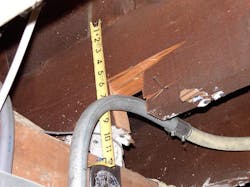How well do you know the Code? Think you can spot violations the original installer either ignored or couldn't identify? Here's your chance to moonlight as an electrical inspector and second-guess someone else's work from the safety of your living room or office. It's your turn to identify the violation.
Hint: Buenas notches!
Find the Answer
Building codes specify exactly when, where, and how big of a hole or notch can be made in studs, rafters, joists, and other wooden framing members. Where there is no weakening of the building structure — in both exposed or concealed locations, Section 300.4(A)(2)of the 2011 NECpermits"cables or raceways to be laid in notches in wood studs, joists, rafters, or other wood members."
Now I'll be the first to admit that I'm not a structural engineer, but this particular floor joist has begun to split from the huge notch that was made in it. My experience tells me this notch may be too large compared to the size of the joist. Of course, the AHJ will have to make the final call on this issue.
If the notch is permitted, then 300.4(A)(2) also requires the cables or raceways at those points to be "protected against nails or screws by a steel plate at least 1⁄16 in. thick, and of appropriate length and width, installed to cover the area of the wiring." Steel plates would not be required to protect rigid metal conduit (RMC), intermediate metal conduit (IMC), rigid PVC, rigid RTRC, or electrical metallic tubing (EMT) in accordance with Exception 1. A thinner hardened steel plate is permitted if it is "listed and marked" in accordance with Exception 2.
> Try Another Quiz
About the Author

Russ LeBlanc
Owner
Russ started in the electrical trade as an apprentice in 1985. He worked his way up to become a Journeyman Electrician and then eventually became a Master Electrician and Licensed Construction Supervisor. In 1999 Russ become an Electrical Instructor for The Peterson School of Engineering in Massachusetts where he developed his passion for teaching, and quickly became Department Head of Electrical Instruction. Russ has taught thousands of apprentices, electricians, engineers, inspectors, and other electrical professionals during his career as an instructor. He continues to provide electrical professionals with Electrical Code seminars, Arc-Flash Awareness training seminars and educational material through his LeBlanc Consulting Services in North Reading, MA whose specialty is educating electricians. He has been an active member of the NFPA Electrical Section and has authored hundreds of National Electrical Code proposals and comments which have become Code rules to improve the safety for the electrical industry. Russ is also an IAEI certified Electrical Inspector.
Please visit www.russleblanc.net for more information.

